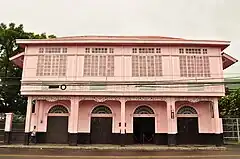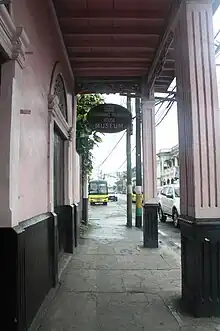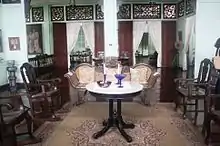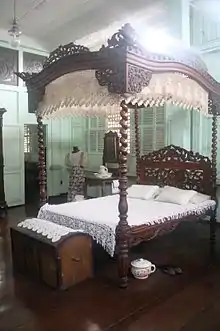Bernardino Jalandoni Museum
The Bernardino Jalandoni Museum, also known as the Bernardino Jalandoni House, located along Rizal Street, Silay City, in the province of Negros Occidental, Philippines, is the original residence of the late Don Bernardino and Doña Ysabel Jalandoni. The museum is also known as the "Pink House" because of its conspicuous pink paint that easily grabs attention.[2]
 The facade of the Bernardino Jalandoni Museum | |
.svg.png.webp) Location within Philippines | |
| Established | 1908[1] |
|---|---|
| Location | Rizal Street, Silay City, Negros Occidental, Philippines |
| Coordinates | 10.801858°N 122.977309°E |
| Type | lifestyle museum |
| Curator | Silay Heritage Foundation, Inc. |
| Public transit access | bus, jeepney, pedicab, tricycle from any point in the city |
History
Don Bernardino and Doña Ysabel Lopez Ledesma were originally from Jaro, Iloilo City and migrated to Silay, Negros Occidental where they eventually settled and raised their children.[3] In Silay City, along the main highway, they built their house which depicts the typical opulent houses during the early 20th century. The house was completed in 1908.
The portion of the street right in front of the Jalandoni House is narrower than the rest of the highway because a group of Silaynons fought for the preservation of the heritage houses when a road expansion project threatened to demolish these old structures, which included the ancestral home of the Jalandonis.

On 6 November 1993, the National Historical Institute declared the Jalandoni House a National Historical Landmark, the first to be recognized as such in the City of Silay.[4]
Mr. Antonio J. Montinola, the grandson of Bernardino Jalandoni by his only daughter Angeles Jalandoni Montinola, who inherited the house, have placed the care and maintenance of the Museum to the Silay Heritage Foundation, Inc. It is often used as a venue for artistic, cultural and education events and performances.[5]
Art & architecture
The design of the Jalandoni House, with its square shape elevated by posts or stilts and roof construction, It is a Bahay na Bato which based from the structure of a typical nipa hut in the Philippines although the former is larger in scale than the latter. The two-storey house is made of balayong, a hardwood that had to be shipped by the Jalandonis from Mindoro.

In its interiors, the ceiling is made of embossed steel trays that were brought from Hamburg, Germany. The wooden transoms are cut out style or callado that infuses elaborate French design. Capiz shells are used in the large window panels for better lighting, ventilation and security.[6]
In the first floor, two carts and a horse carriage were on display as the ground floor used to function as a garage. Most of the activities were held on the second floor, and where most of the artifacts are kept. As such, the living room, bedrooms, kitchen and dining room are all located in the upper floor.

The living room and receiving area display an old Steinway piano, a gramophone, a sewing machine, an old telephone, and several paintings. Inside the bedrooms are four-post beds, chamber pots, and a birthing chair. The kitchen shows old items used for daily activities, such as the heavy chopped woods known as the prinsa de paa and prinsa de mano, as well as the round irons used to press clothes.[7]
References
- "Bernardino Jalandoni Ancestral House information". Lonely Planet. Lonely Planet. Retrieved 15 October 2014.
- Tantengco, Cristina (26 June 2013). "48 Hours in Bacolod: A 'Biyahe ni Drew' itinerary". GMANetwork.com. GMA Network. Retrieved 13 September 2014.
- "Spanish Economic Reform- Sugar Industry". Research Center for Iloilo. Archived from the original on 9 October 2014. Retrieved 16 October 2014.
- Lapres, Tina (22 December 2002). "Silay: The Paris of Negros". The Philippine Star. The Philippine Star. Retrieved 16 October 2014.
- Betancourt, Daniel (December 2007). "Housing Our Rich Past". Cebu Smile. Smile Magazine. Retrieved 13 September 2014.
- Calapati, Jimmy (5 June 2006). "Heritage Festival ends in tour of Negros, Iloilo houses". MECO. Manila Economic and Cultural Office. Archived from the original on 5 March 2016. Retrieved 16 October 2014.
- Morales, Izah (November 2012). "A Glimpse of Historic Silay". Zest-Air Inflight Magazine. Zest-Air. Archived from the original on 26 October 2014. Retrieved 13 September 2014.